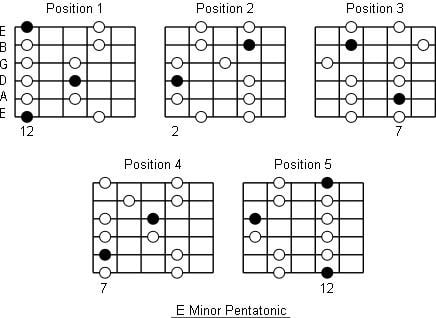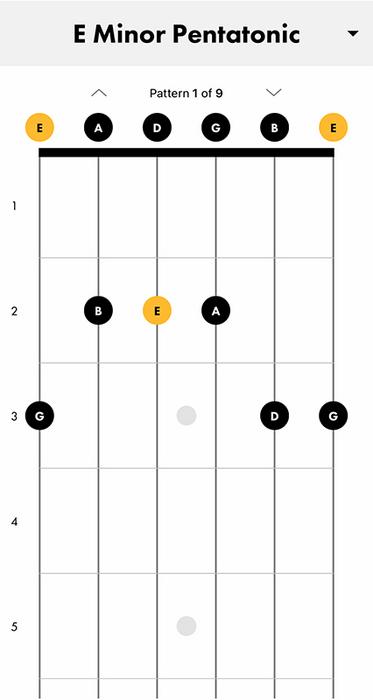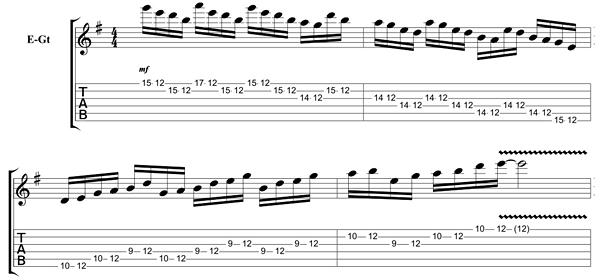There I was, standing on an empty stage in front of an excited crowd of hundreds, the spotlight cutting through the darkness. My fingers fluttered hesitantly over the frets. I knew that the E minor pentatonic scale would make or break my performance that night. The gratifying applause, the thundering cheers, the electrifying energy – it all hung in the balance. The concluding segment of my journey to mastering the E minor pentatonic scale on guitar was about to unfold. What happened next will surprise you but let’s pause the narrative here.
Bearing the power of transformations and moments like these, the E minor pentatonic scale represents a pivotal cornerstone in guitar playing. The sheer versatility of this scale across genres from blues to rock, its potent expressiveness, and the beautiful simplicity of its structure, make it an essential part of any guitarist’s musical vocabulary.
To those ready to embark on a musical journey and embrace the power of the E minor pentatonic scale, welcome aboard! This comprehensive guide is designed to take you on a deep dive into the world of the E minor pentatonic scale, its structure, techniques, and application, offering you a front-row seat to unveiling its mysteries.
Understanding the E Minor Pentatonic Scale
Structure of the E Minor Pentatonic Scale

Having explored the overarching concept of the E Minor Pentatonic Scale, let’s delve into its distinct structure. The beauty and allure of the E Minor Pentatonic scale lies in its five-note construction, namely: E, G, A, B and D. The word ‘Pentatonic’ literally means ‘five-tones’, further emphasizing the essential characteristic of this guitar scale.
The structure is simple, yet fascinatingly versatile. Its widely loved and used because of this simplicity, which offers an almost universally pleasant sound to listeners. The intervals that make up this melodic construct are the root note (E), minor third (G), perfect fourth (A), perfect fifth (B), and minor seventh (D), which when played together, echo a hauntingly beautiful, bluesy emotion.
The E Minor Pentatonic is incredibly forgiving and fluid, which is why understanding this scale will help you master guitar scale patterns. As part of the bigger picture, the structure of the E Minor Pentatonic Scale is the integral framework that allows guitarists to weave soundscapes, telling emotional stories through melody. Its simplicity enables you to focus more on dynamics and rhythm, rather than worrying about dissonance or clashing harmonies.
For me, this scale was my first step into the world of improvisation. Its simplicity allowed me to creatively experiment without fearing mistakes. This exploration of tonalities proved invaluable, deepening my overall understanding of playing the guitar and musical theory. Reflecting on its importance, the structural understanding of the E Minor Pentatonic Scale is, without a doubt, an essential stepping-stone on the journey to mastering guitar.
The E minor pentatonic scale and The Blues

Having established a comprehensive understanding of the E minor pentatonic scale, we can’t ignore its significance in blues scale guitar music. The E minor pentatonic scale forms the backbone of the blues genre, often acting as a starting point for countless solos, riffs, and melodies.
Delving into the connection between the E minor pentatonic scale and blues, we find an intricate interplay of the E minor pentatonic’s notes, which capture the expressive, resilient spirit of blues music. The combination of its simplicity and flexibility makes it a power tool in a blues guitarist’s arsenal.
Notably, the distinctiveness of this scale in blues isn’t limited to its sound. It’s equally important for its effect on guitar techniques and improvisation approaches, providing a roadmap for myriad creative possibilities. It’s this immense contribution to blues scale guitar music that underscores the value of mastering the E minor pentatonic scale.
Learning to Play the E Minor Pentatonic Scale on Guitar
Scale Positions and Fretboard Navigation

Having gained a solid understanding of the structure and significance of the E minor pentatonic scale, the next progression in our journey of mastery involves an integral aspect of guitar playing – scale positions and fretboard navigation. This crucial knowledge will enable us to translate theoretical understanding into practical application seamlessly, playing the E minor pentatonic scale across the entirety of the fretboard with confidence and fluency.
It’s important to remember that the guitar fretboard positions are like a moving map that can guide our fingers to the desired notes. For effective navigation, we must familiarize ourselves with the five positions of the E minor pentatonic scale. These positions provide a roadmap for our fingers to follow, allowing us to play the scale anywhere on the neck of the guitar.
In emphasizing the significance of learning these positions, let me draw on my own experiences. Before I gained proficiency in fretboard navigation, my capacity to express myself musically felt limited. However, once I had demystified the fretboard, I found that I was able to unleash my full musical potential, and the E minor pentatonic scale was one of the vital tools in this journey.
The first position starts on the open E string, followed by the other four positions, each beginning where the last one ended. They repeat as we move up the neck, calling back to the same patterns albeit 12 frets higher.
Remember, these positions are interlinked. They lay out the E minor pentatonic scale from the first note, E, to the last, D, allowing us to play the scale in a smooth, flowing manner. Rather than stopping at the end of one position and starting again at the next, the positions connect in a seamless, continuous journey across the fretboard.
In the course of my own practice, I’ve always found it beneficial to memorize one position well before moving on to the next. Only after I felt comfortable with each position individually did I start joining them together and exploring the connections between them.
To reiterate, grasping scale positions and fretboard navigation is a cornerstone in mastering the E minor pentatonic scale on guitar. It widens our expressive capability, enabling us to play the scale effortlessly across the entire fretboard. By understanding how these positions intersect and relate to one another, we can freely navigate the fretboard, translating our musical ideas into reality.
Next, we’ll take these principles and apply them to diagrams and tabs, further enhancing our practical understanding of the scale.
Using Diagrams and Tabs

When learning to play the E Minor Pentatonic scale on a guitar, understanding guitar scale diagrams and tabs can be a game-changer. They serve as a visual aid, offering a clear representation of the fretboard and making it easier for you to find your way around. Think of them as a road map, with each dot or number marking your destination points – the notes.
Every box in the diagram represents a fret, and the horizontal lines correspond to the guitar strings. The dots pinpoint the exact fret where a note of the scale is located. Tabs function similarly, but they look more like traditional sheet music. They have six horizontal lines, each representing a string. The number on a line indicates the fret you play on that string. As you can imagine, being able to interpret these tools is fundamental to learning the E Minor Pentatonic scale effectively.
I’ve spent countless hours practicing the E Minor Pentatonic scale, and I can vouch, there’s no better way to get the shapes and patterns under your fingers. And once you’ve become familiar with them, you can then put yourself in the driver’s seat, navigating the fretboard with ease, and most importantly, making music that pleases your ears.
Cracking the code of diagrams and tabs bridges the gap between simply playing the notes and understanding the structure of the scale. Over time, this will help you to develop a more intuitive, reflexive grasp on the E Minor Pentatonic scale, increasing your fluency and confidence as a guitar player.
In my playing and in my teaching, I’ve found that the diagrams and tabs aren’t just useful directions, they provide a space to find your own rhythm, your own style – they offer an opportunity to make the scale, and indeed your musical journey, truly your own.
As we move forward, we’ll be applying what we’ve learned to play some real music. But remember, every guitarist’s journey is a personal one, fueled by persistent practice and an undying love for music. And it all begins with mastering fundamentals like scale diagrams and tabs.
Applying the E Minor Pentatonic Scale in Music
Pentatonic Scale Exercises

At this juncture, we have gained a robust understanding of the structure and application of the E Minor Pentatonic Scale. Now, let’s delve into the practical aspect, specifically, the pentatonic scale exercises. Becoming proficient at using this scale in music involves extensive practice to cultivate the necessary speed, fluidity, and precision.
I’ve created some exercises which highlight the unique flavour of this scale and challenge your technical skills. I’d recommend taking it slow at first, focusing on precise fretting and picking. Gradually increase your speed only when you are comfortable with the intricacies of the notes and their relationships. Remember, the aim of these exercises is not just dexterity, but also to train your ears to recognise the characteristic sound of the E Minor Pentatonic Scale.
These exercises are also a great opportunity to experiment with your own musical ideas. Play around with the scale’s intervallic relationships, try to create your own licks and melodies; this is where the real creativity lies in applying the E Minor Pentatonic Scale in your music. Remember, effective practice includes both repetition and creative exploration.
To conclude, employing pentatonic scale exercises is a fundamental step towards mastering the E Minor Pentatonic Scale, providing a foundation upon which to build your musical expressions. Keep an open mind and enjoy the journey, as the scope for creativity is endless here.
FAQs
What is the E Minor Pentatonic Scale on Guitar?
How to master the E Minor Pentatonic Scale on Guitar?
What are some practical applications of the E Minor Pentatonic Scale?
Conclusion
So, can mastering the E minor pentatonic scale transform your guitar journey? Let’s recap. We’ve thoroughly dissected the essential anatomy of the E minor pentatonic scale, given you a dynamic roadmap to nimbly navigate across the fretboard, and imbued you with practical ability to apply these melodic patterns in real-world music. This isn’t just about academic understanding—it’s a call to experience music on a deeper level, to feel these primal resonances course through your fingers, and infuse your playing with soulful authenticity. The core insight here? Mastering the E minor pentatonic scale doesn’t just make you a better guitarist—it liberates your musical expression. To put it simply, it’s a game-changer.